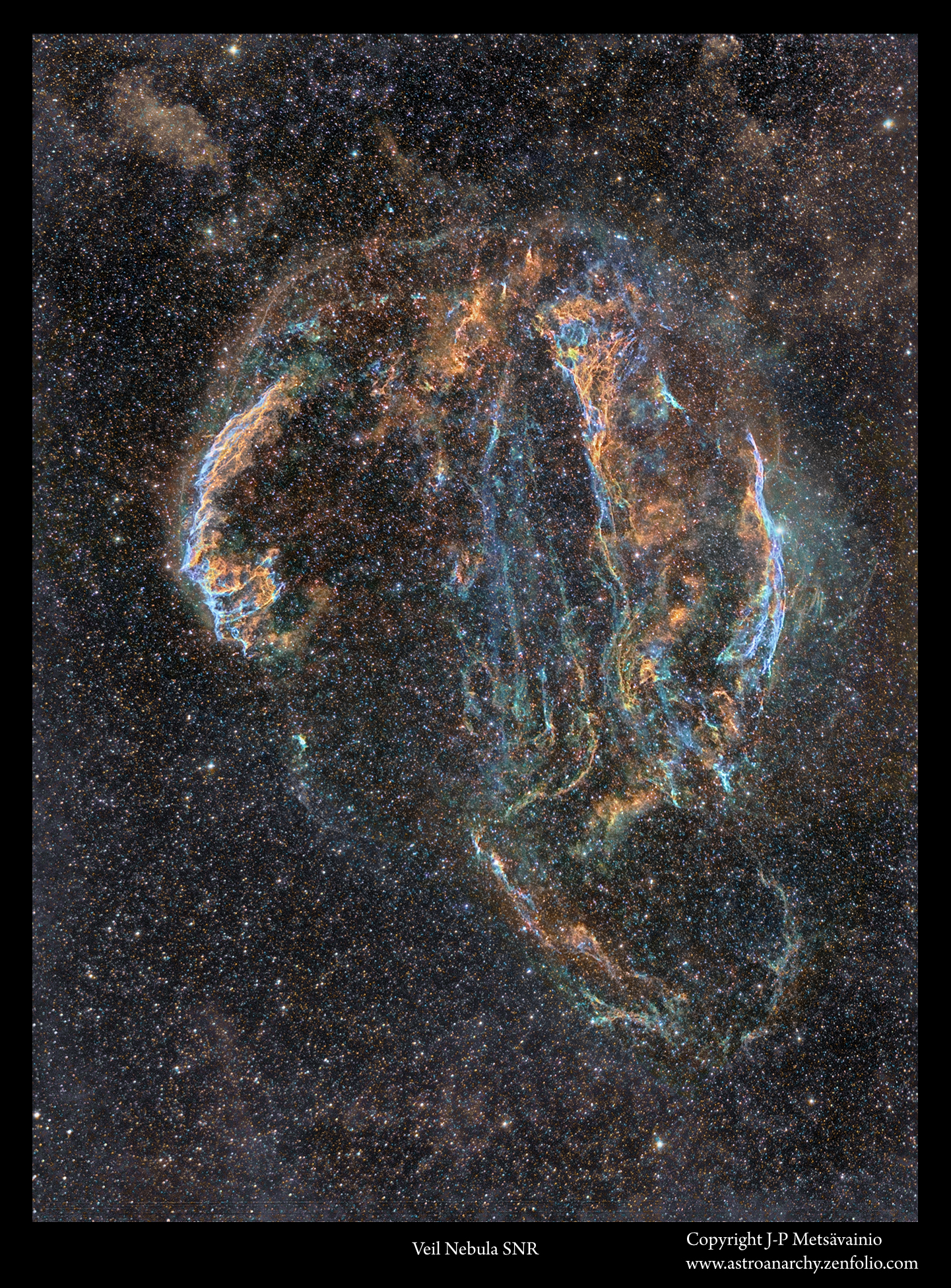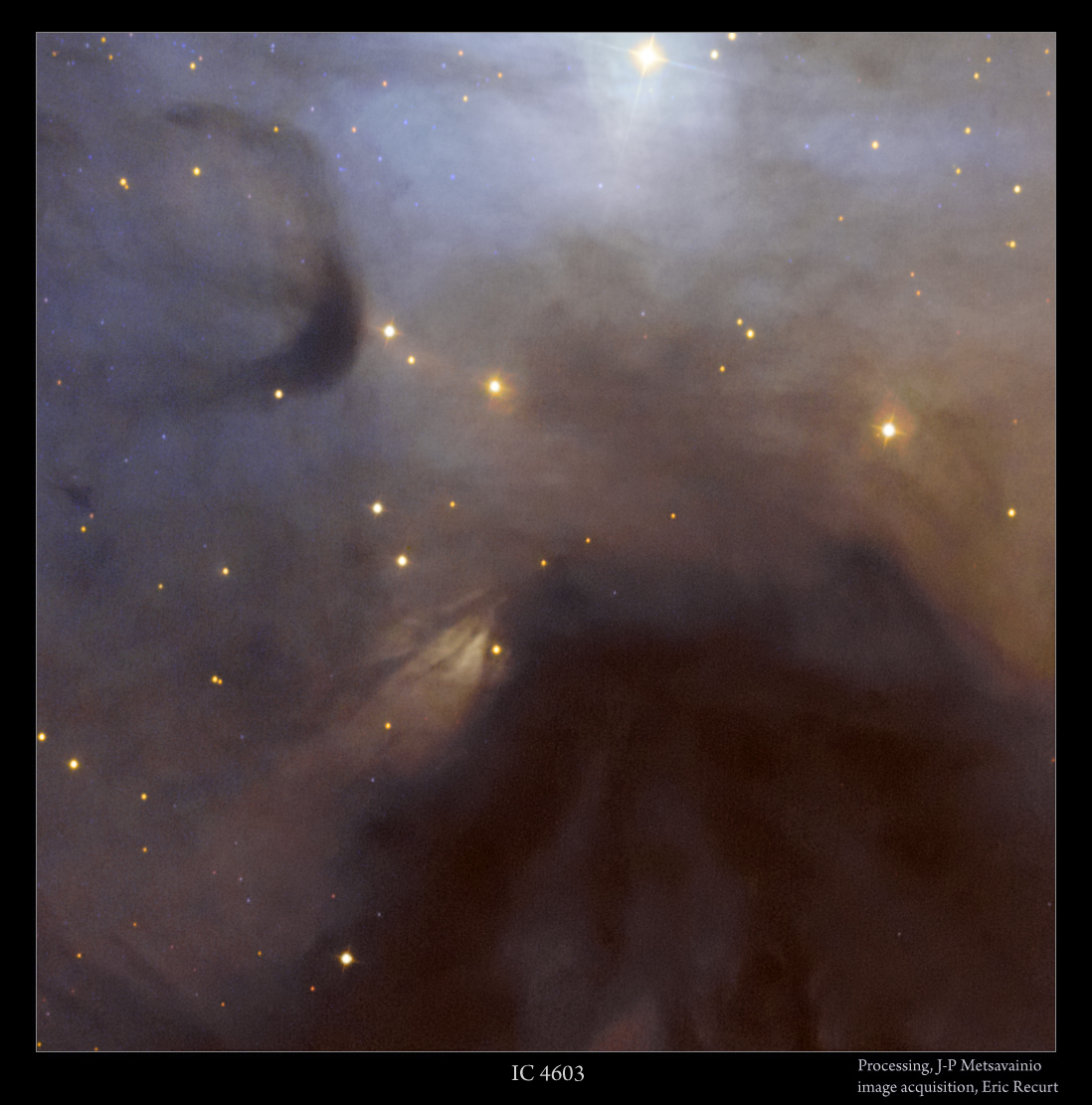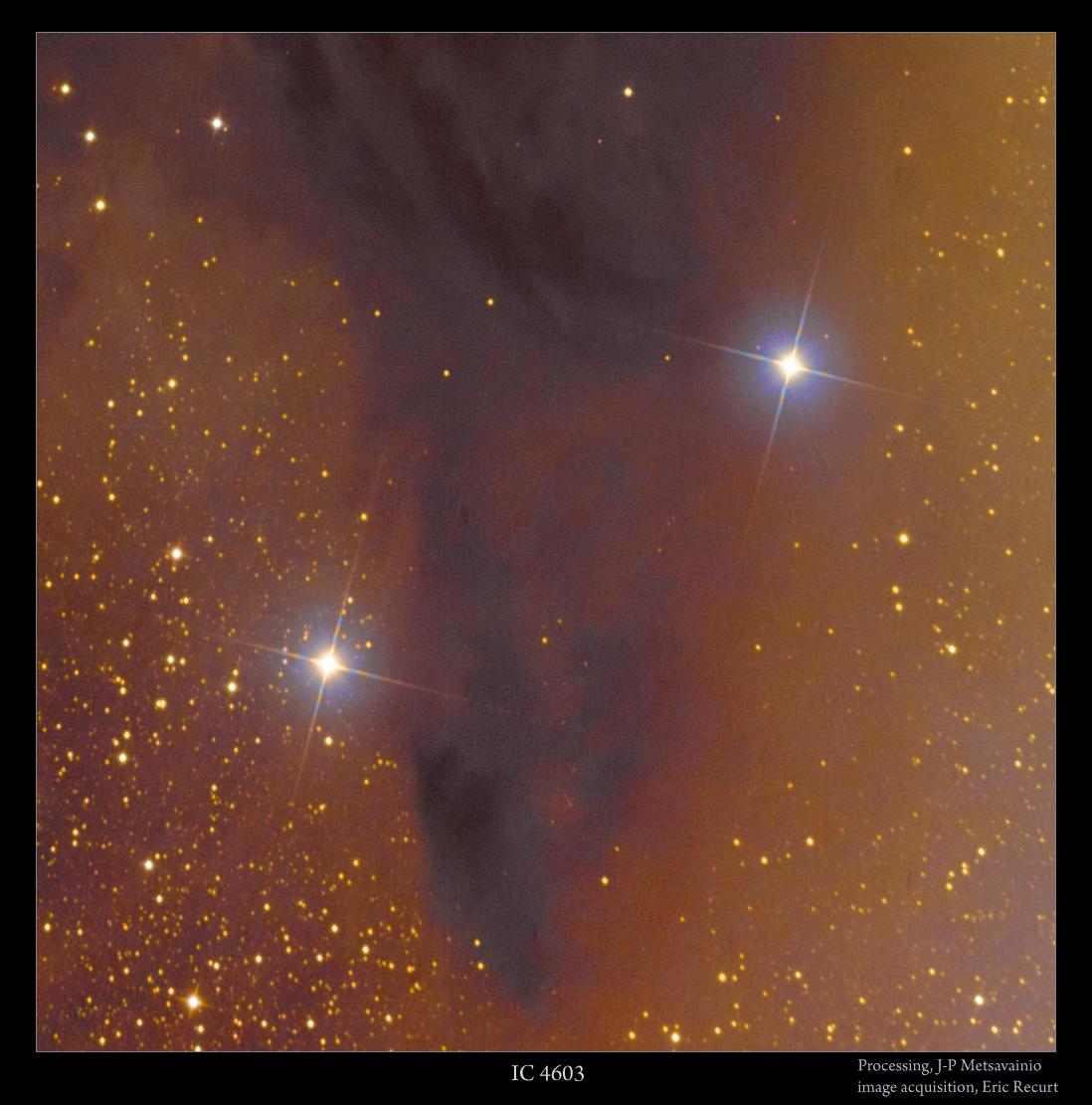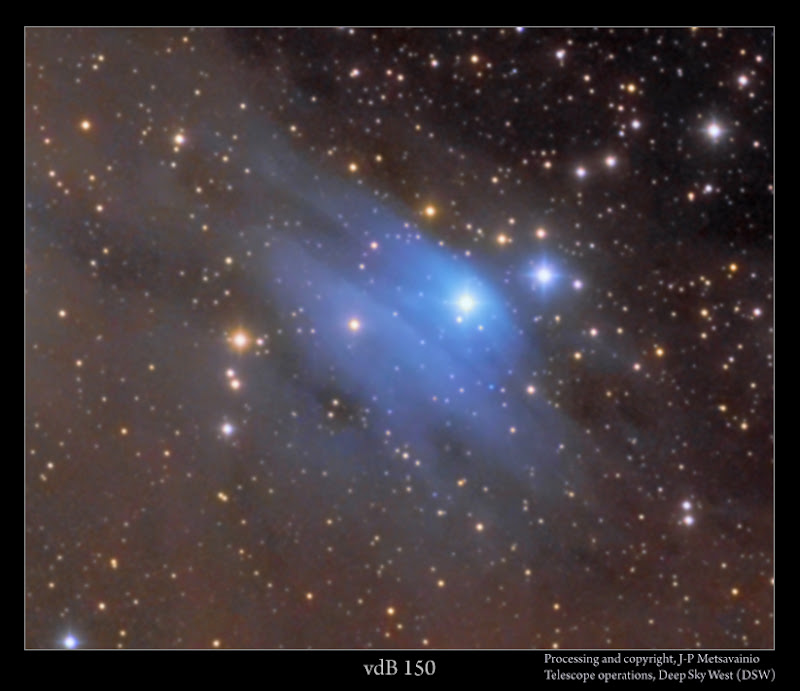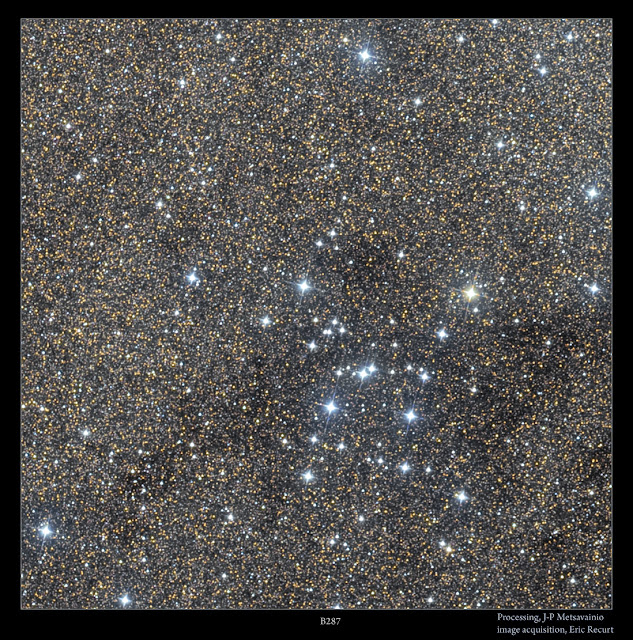COPYRIGHT, PLEASE NOTE
All the material on this website is copyrighted to J-P Metsavainio, if not otherwise stated. Any content on this website may not be reproduced without the author’s permission.
Have a visit in my portfolio
PORTFOLIO:https://astroanarchy.zenfolio.com/
Tuesday, September 15, 2015
Pickering's Triangle, my first light for the Autumn season 2015
This is my opening photo for the Autumn season 2015. I started this imaging project a year ago, at Autumn 2014. Back then I shot 12h of the light form an ionized oxygen, O-III. This is a two frame mosaic of the Veil Nebula supernova remnant. This Autumn I shot 5h of light from an ionized hydrogen, H-alpha. I was able to make a Hubble palette image by using the S-II from my older wide field photo of the Veil Nebula.
Pickering's Triangle
Be sure to click for a large image!
Part of the two frame mosaic of the Veil Nebula supernova remnant, the Pickering's Triangle.
Colors are from the ionized elements, Hydrogen, Sulfur and Oxygen.
S-II = Red, H-alpha = Green and O-III = Blue.
(A content of this O-III image can be seen as a blueish color at image above.)
Pickering's Triangle in light of an ionized oxygen, O-III, alone.
A closeup
Click for a large image
A less zoomed version
Click for a large image
The whole two frame mosaic
Click for a large image
A two frame mosaic of the Pickering's Triangle
A wide field photo of the Veil Nebula supernova remnant
The Pickering's Triangle can be see at one o'clock position.
My blog post about the wide field shot can be seen HERE.
Technical details
Processing work flow
Image acquisition, MaxiDL v5.07.
Stacked and calibrated in CCDStack2.
Deconvolution with a CCDStack2 Positive Constraint, 33 iterations, added at 33% weight
Color combine in PS CS3
Levels and curves in PS CS3.
Imaging optics
Celestron Edge HD 1100 @ f7 with 0,7 focal reducer for Edge HD 1100 telescope
Mount
10-micron 1000
Cameras and filters
Imaging camera Apogee Alta U16 and Apogee seven slot filter wheel
Guider camera, Lodestar x2 and SXV-AOL
Astrodon filter, 5nm H-alpha
Astrodon filter, 3nm O-III
Astrodon filter, 3nm S-II
Exposure times
H-alpha, 15 x 1200s = 5h
O-III, 36 x 1200s binned = 12h (Autumn 2014)
S-II, from my older wide field photo of the Veil Nebula = 3h
Total 20h
Labels:
Narrowband color images,
nebula
Tuesday, September 8, 2015
IC 4603, at the core of the colorful Scorpion
This is a third image produced as a collaboration with me and Eric Recurt. The data is shot from his observatory at Tenerife. The Observatory locates at 2400 m altitude and at 28 degrees North. The site has excellent seeing conditions, 0.8 " on average and can be below 0.3 "
IC 4603, the core region of the Rho Ophiuchi complex in the constellation Scorpion
Click for a full size image
This is a broadband LRGB natural color image of the IC 4603 from a remote observatory in Tenerife.
Full scale closeups
Click for a full size image
Technical details
This is a broadband LRGB natural color image of the IC 4603 from a remote observatory in Tenerife.
Full scale closeups
Click for a full size image
Technical details
Processing workflow
Deconvolution with a CCDStack2 Positive Constraint, 27 iterations, added at 33% weight
Color combine in PS CS3
Levels and curves in PS CS3.
Imaging optics
340mm F3.3 astrograph
Mount
ASA DDM 85
Cameras and filters
FLI PL 16803
Exposure times
Luminance, 10 x 300s
Red = 10 x 180s
Green = 9 x 180s
Blue = 8 x 180s
Total 2h 11min
Labels:
nebula
Sunday, September 6, 2015
"Howling Wolf" Nebula, vdB 149, vdB 150, LDN 1235 and PGG 67671
The second photo published from the Deep Sky West observatory. Lights are taken under a very dark skie. Unlike in my current light polluted location, it's now possible to image broadband targets, galaxies, reflection nebulae and dark nebulae! HERE is some more info about the Deep sky West Observatory.
I gave the nickname "Howling Wolf" after I saw the photo first time in my monitor. At the end of this blog post, there is an explanation for the nickname.
VdB 149 and companions in the constellation Cepheus
Click for a large image
Beautiful collection of dark and reflection nebulae in Cepheus including a galaxy. This is a broadband LRGB image in natural colors.
Full resolution details from the image above
LDN 1235
vdB 150
vdB 149
vdB 149 and some interesting shapes in the dust cloud
Click for a large photo
PGG 67671
An experimental starless version
Click for a large photo
A starless version to show better the actual dust cloud
Howling Wolf
This is how I see the photo in my head.
An animated GIF, stars vs starless
Click for a large image
Technical details
Processing workflow
Stacked and calibrated in CCDStack2.
Deconvolution with a CCDStack2 Positive Constraint, 27 iterations, added at 33% weight
Color combine in PS CS3
Levels and curves in PS CS3.
Imaging optics
Takahashi FSQ-106EDXIII
Mount
Astro-Physics Mach1AP GTO with GTOCP3
Cameras and filters
QSI683WSG
Astrodon Luminance Tru-Balance E-Series Gen
Astrodon Red Tru-Balance E-Series Gen 2
Astrodon Green Tru-Balance E-Series Gen 2
Astrodon Blue Tru-Balance E-Series Gen 2
Exposure times
Luminance, 32 x 900s = 8h
Red = 13 x 900s = 3.25h
Green = 12 x 900s = 3h
Blue = 5 x 900s = 1.25h
Total 15.5h
Labels:
nebula
Friday, September 4, 2015
Half a million stars and Messier 7
This is a second image produced as a collaboration with me and Eric Recurt. The data is shot from his observatory at Tenerife. The Observatory locates at 2400 m altitude and at 28 degrees North. The site has excellent seeing conditions, 0.8 " on average and can be below 0.3 "
Messier 7, "My God, it's full of stars!"
Be sure to click for a full size image! (Quote, 2001: A Space Odyssey)
Just right from the Messier 7 locates a dark nebula B 287. In this image is visible about 500.000 stars of our Milky Way. Click the photo to see all of them! (2100x2100 pixels)
A closeup of Messier 7
Click for a large image
Planetary nebula PN Hf2-1
Click for a large image
Planetary Nebula PN Hf2-1 is a blue dot at middle of the image area.
INFO
Technical details
Processing workflow
Deconvolution with a CCDStack2 Positive Constraint, 27 iterations, added at 33% weight
Color combine in PS CS3
Levels and curves in PS CS3.
Imaging optics
340mm F3.3 astrograph
Mount
ASA DDM 85
Cameras and filters
FLI PL 16803
Exposure times
Luminance, 11 x 300s = 55min
Red = 6 x 180s = 18min
Green = 6 x 180s = 18min
Blue = 6 x 180s = 18min
Total 1h 49min
Labels:
star clusters
Subscribe to:
Posts (Atom)






